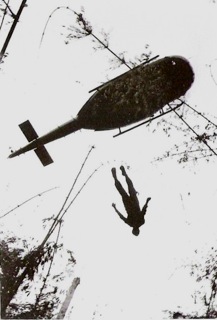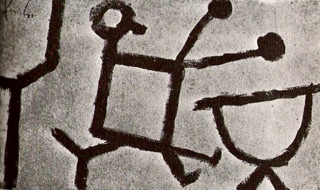|

|
An Evacuation Helicopter Near the Cambodian Border, 1966
after
an Associated Press photograph
The body seen from below floats in the air
as if suddenly it has found itself free
and nothing, no flurry of rain nor swaying
branch or beating rotor, can disturb the relaxed
nature of its floating. If the eye saw only
the flat shapes of this world instead of the rounded
edges, the volume and eye-measured weight
to which the mind assigns direction, then gravity's
deliverance would not pull every body back
home to lie upon our chests and conform
to our ribs, a return to its first place
of departure. For the body seen from below floats
both away from us and hurls itself downward.
We suffocate in the leaving. We die
in the returning. How can we bear
the burden of what we can't carry, the absolute
surrender of this body being lifted, arms open,
legs parted, the head like a weight being pulled
last and finally through the waving, stripped
branches of the jungle's canopy, lifted
by cord and hook into the furious silence.
|

|
October Field
after
a photograph by A. Aubrey Bodine, 1950's
Bloody Row Antietam lifts
plots of corn cracked
and dried bone-white.
Already someone has cut
a path halfway across the field
gathered the stalks
then tied and stacked
the leaning sheaves
next to the road between
a fence and two stone
markers where overhead
the skeletal tree limbs
gleam thin and sharp
as a surgeon's knife.
The Club—South Side, 1957
after
a photograph by W. Eugene Smith
The door wears eyes—
two metal holes
sunk in wood.
A lock plate rubbed smooth
by oiled hands
and a pane
of dirty glass textured
as a winter storm
where beneath are scrawled the words:
Members Only
Show Your Card
and overhead
two silver threads
tremble a nervous tic
caught inside
the yellow light bulb's
soot rinsed mouth.
|

|
Meditation on a Drawing by Paul Klee, 1940
What you have loved
is poured out
between black lines scratched on cheap white paper
drawn in the second floor rooms of the small house in the Kistlerweg—
Where to walk
the blunt walk of the nub's charred point
is to stay
in the one thought
mulled over and over.
One line marks where the skin had been stretched.
The metal ring pulled on and clamped
to cover the emptiness—
Then, drawn beneath, two lines
make a tripod for bearing the kettle.
With two strokes, the drummer's legs kick out.
And with two more, the arms find
at their end
two fists, each grasping a stick
that lifts— until one fist falls.
And then another.
How to make from wood and fire
the sound of what is disappearing?—
How to enter this blank paper
as if it were the body holding
what in you must be silent—
and let that silence
find sanctuary within
the drawn line
of a river
drummed into thundering currents
until you will have made the one perfect circle
that remains closed
and bears what stays inside
quiet as heartwood
unclenching in you
dread's oversized hands.
The Boy in the 1952 Snapshot
All these years you've drawn the boy's arms over and over
How is it he stays on with you all his knowing
locked inside eyes the camera long ago caught—
his boy chest bursting forth from beneath the too small shirt
and a frayed cord wrapping his waist holding up both pairs of
pants
Decades now you have carried him out into daylight
You have carried him into rooms gritty with soot
a fury of bees caught in the wall
You have carried him across studio floors crusted with
charcoal
air heavy with fumes of thinner and resin—
Traveling south and west he has stayed withdrawn and
somnolent
through Charlottesville and into Chicago listening
to you saying—because you don't know and you must know—
Was it Mississippi Was it Arkansas or Alabama—
Did your mother hold the camera—
Or was it her lover—
who set him posing for their pennies
before the half-scrubbed cotton field
beneath the shallow bank of clouds
now bled into yellow?
Still he goes on with you ghost-like not turning
his almost man-size hands the two iron-like weights fallen
to rest halfway down his thighs the rungs of his pants' torn
knees
droop like two half-closed eyes
the skin beneath faded as the sallow sky place
where the hidden God's eyes have gone
distant country over the hilltop where two arms arc out
from the shoulders to form the bow of a departing boat
or the peak turning downward of the cathedral window
that you are—even now— still drawing.
Marie Pavlicek-Wehrli,
painter, printmaker, and poet, is a graduate of Seton Hill University (B.A.,
Studio Art) and Warren Wilson College (MFA, Creative Writing). She has been a Fellow at both the Virginia Center for the Creative Arts and the
Ragdale Foundation, as well as resident artist at Wesley Theological Seminary
in Washington, D.C. Her paintings and prints have been exhibited locally
and regionally and her poems have appeared in various journals and anthologies.
She is a recipient of a Maryland State Arts Council Individual Artist's
Grant in Poetry. Her website is www.mariepavlicek.com